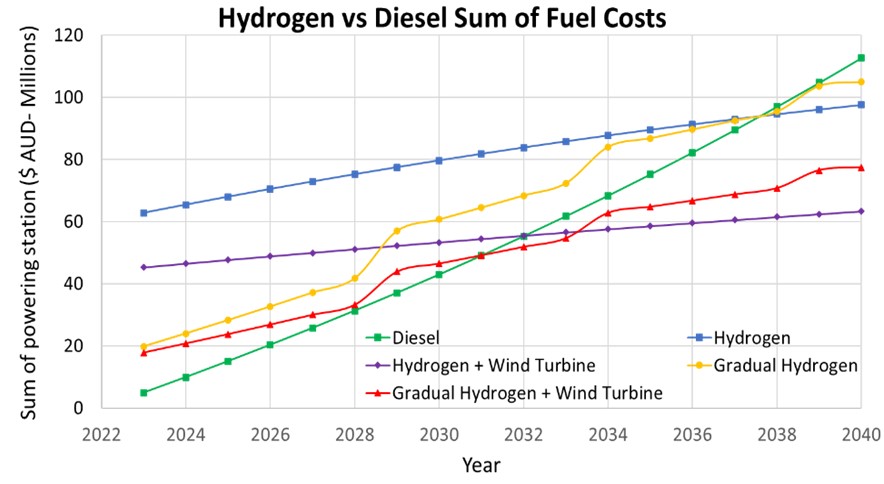 Antarctica is vital for cold research, from understanding our fragile climate to tracking local fauna. Energy is critical to this research as it supports expeditions and heating bases. Reliance on diesel import is leaving a dark legacy on the continent, as the buildup of black carbon is causing accelerated rates of animal birth defects and melting ice shelves.[1,2] We must transform our Antarctic fueling practices with urgency if we are to preserve our last clean continent.
Antarctica is vital for cold research, from understanding our fragile climate to tracking local fauna. Energy is critical to this research as it supports expeditions and heating bases. Reliance on diesel import is leaving a dark legacy on the continent, as the buildup of black carbon is causing accelerated rates of animal birth defects and melting ice shelves.[1,2] We must transform our Antarctic fueling practices with urgency if we are to preserve our last clean continent.
Liquid hydrogen (LH2) can offer a reimagining of clean Antarctic energy, with its versatility for import or onsite production to power bases and vehicles through combustion and fuel cells. Like diesel, LH2 must undergo similar adaptations to withstand the harsh, isolated conditions of Antarctica. Adopting LH2 will require an assessment of potential end-use technologies for enhanced research and an economic assessment of energy supply pathways. As a student team across Monash University, Australia, and the HYPER Center at Washington State University, we explored the potential of LH2 for Australia’s largest Antarctic base, Mawson Station.
Technology Assessment
Any Antarctic technology must advance the Australian Antarctic Division’s (AAD) commitment to enhancing environmental research while minimizing the footprint of operations. Green LH2’s high gravimetric energy density could enable the use of near-silent fuel cell-powered unmanned aerial and submersible drones (UAV, UUV) for long duration surveying. A semi-quantitative assessment was conducted to identify the opportunities and challenges of adopting both technologies for Antarctic research. Factors considered ranged from technology readiness, performance in Antarctic conditions, safety, and perception by researchers. The major opportunities and challenges are highlighted in Table 1.
The assessment showed green LH2 could cut carbon and improve Antarctic research. Small-scale demonstration of LH2-fueled UAVs is possible by utilizing existing infrastructure. However, larger-scale LH2 energy adoption would require personnel training and a larger supply chain.
 Economic Assessment
Economic Assessment
Mawson annually imports 900,000 liters of diesel, costing $5 million AUD and 2.5 million metric tons of CO2.[3] Economic studies assessed the cost of transitioning Mawson’s energy supply from diesel to LH2 import by considering the OpEx of liquefaction and shipping with the CapEx of storage tanks. AAD historical records indicated 65,000 kg/year of LH2 would be required to substitute current diesel use. Importing LH2 from S.E. Australia would incur a 3x shipping cost multiplier on top of an assumed production cost of $5 AUD / kg LH2. The long-term costs of LH2 adoption were quantified by considering the following energy supply scenarios:
100% diesel use continued; 100% immediate transition to imported H2; installing a second wind turbine and import H2 for firming; a gradual increase to 100% H2 use over a 15-year period; and installing a second wind turbine and increase H2 use over a 15-year period.
Figure 1 indicated that LH2 import coupled with renewable generation would be more cost-effective than diesel in the long run. Further work is required to quantify the relative costs of energy to supply base power, heating and equipment and how on-site LH2 generation scenarios with renewables could compare on cost.
Resolving the potential for LH2 to advance researchers' commitment to minimize the environmental footprint of exploration will require further techno-economic modeling of on-site production and use scenarios. Expertise sharing on liquid hydrogen technology performance and personnel requirements for deployment will be critical in building the foundation for liquid hydrogen-fueled research. Antarctica is our world's most fragile natural environment, but it has the potential to be a sustainability role model for the rest of our world. HYPER Center and Monash are continuing this work, and expertise sharing from the nexus of cryogenic engineers could accelerate Antarctic liquid hydrogen adoption. [email protected].
References
[1] Cordero, R. R., Sepúlveda, E., Feron, S., et al. (2022). Black carbon footprint of human presence in Antarctica. Nature Communications, 13, 984.
[2] Fretwell, P. T., Boutet, A., & Ratcliffe, N. (2023). Record low 2022 Antarctic Sea ice led to catastrophic breeding failure of emperor penguins. Communications Earth & Environment, 4, 273.
[3] Australian Antarctic Division. (n.d.). Australian Antarctic Program. Australian Antarctic Division.
Table 1: Analyzing hydrogen-powered UAV/UUV adoption via Antarctic interviews and criteria. Credit: Gitter and Turner
Figure 1: 18-year trends comparing current diesel usage and scenarios for LH2 energy transition. Credit: Gitter and Turner


